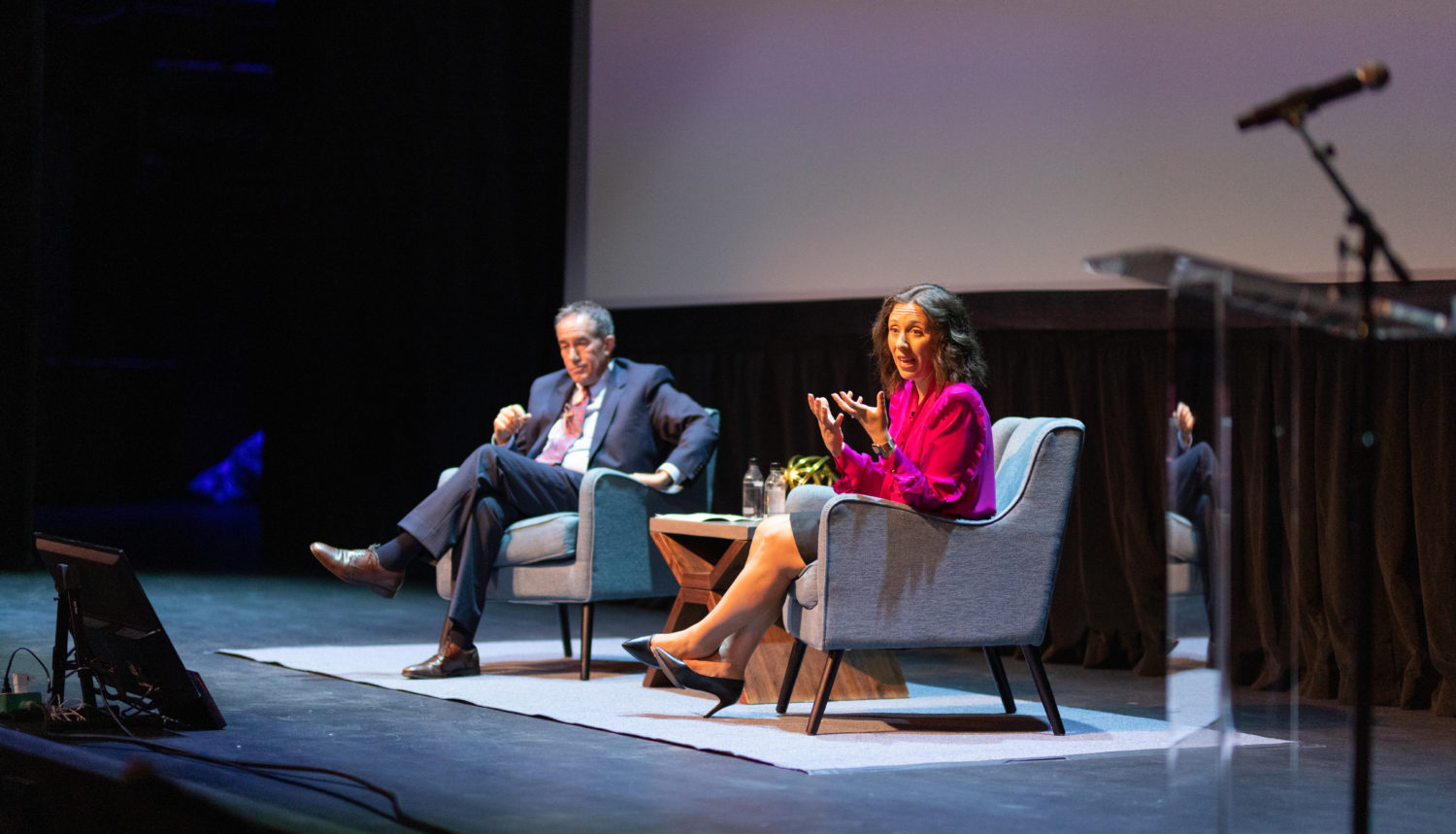At a time when trust in media has hit historic lows, The Associated Press is trying to stick to “good, solid, fact-based journalism.”
“I hear all the time people saying, ‘Gosh if only there was a news organization that … wanted to cover the facts and cared about local news.’ And hey, we’re right here,” said senior vice president and executive editor Julie Pace. “There is a public interest and premium for the exact kind of journalism that we do.”
Pace’s remarks came Tuesday during a conversation with Poynter president Neil Brown at the Straz Center for the Performing Arts in Tampa. That discussion was the first in a new speaker series hosted by Poynter that will feature journalists, experts, and community leaders in conversation about current issues.
Pace, who served as the AP’s Washington bureau chief before becoming executive editor, recounted the shift she saw during the 2020 election week, which she described as one of the most intense in her career.
“This was the first election where it was clear that just because we at the AP were accurate and transparent about what we were doing, there was not going to be this built-in acceptance of those race calls,” Pace said. “It was just unnerving.”
Though there is pressure to be the first to call an election race, accuracy is more important, Pace said. In the months leading up to an election, the AP Decision Desk researches rule changes in each state to adjust its models. For the 2022 midterms, the AP has hired 5,000 election stringers across the country to help call in results.
“I think because of who we are, we can’t get this wrong.” Pace said. “Particularly in this environment, if we call a race wrong, that’s not just the AP screwed up — that is diminishing trust in democracy.”
Other controversial topics receive this same facts-first approach at the AP. Though some deny the impacts of climate change, the AP refuses to present that perspective since the “facts are clear on this issue,” Pace said. The AP created a standalone climate desk earlier this year and has incorporated climate reporters into its coverage of natural disasters, including the recent Hurricane Ian.
“In the last couple of years, we’ve actually filled in climate reporters into the coverage plan around hurricanes. And that is the same way we deal with forest fires or any major natural disasters because there are climate aspects to all of these storms,” Pace said.
The media’s coverage of race and inequality — especially in the wake of the summer 2020 Black Lives Matter protests — has brought into question traditional journalistic values like neutrality and objectivity. Pace said that when it comes to issues like racism or sexism, the AP doesn’t want to be neutral.
At the same time, there are some issues on which the AP cannot take a position. Pace gave abortion as an example.
“Abortion is an issue that is divisive, and people genuinely fall on different sides of that issue. They feel very passionately.” Pace said. “I think that actually is a place where having the ‘both sides’ conversation is very relevant. But I also want to make sure that we don’t present things with equal weight sometimes.
“We make sure that if an issue does have two sides, but the public polling shows that the bounds tips one way or another, we are always going to reflect that.”
While reporting on highly charged issues, the AP strives to present readers with the facts and allows them to make their own conclusions. One example of this was a transcript the AP published of an interview between Pace and former President Donald Trump.
“It’s a great example of how we view our role,” Pace said. “Here’s the transcript, word for word. Just take it. Make what you want of it, think what you want of it.”
Pace’s tenure as a White House reporter for the AP also overlapped with former President Barack Obama’s term. She said the two presidents were extremely different. Obama was more standoffish, controlled and disciplined, Pace said. Trying to report what he was thinking could take days of sourcing. Trump, however, shared his thoughts widely — often in the form of a tweet.
“It was so extraordinary after covering Obama, where, again, you could just kill yourself trying to get one small anecdote from one Oval Office meeting, and you would be really proud of yourself when you did it,” Pace said. “And with Trump, people would be leaking you things while the Oval Office meeting was happening.”
Media workers have faced increasing animosity in the field. During the Jan. 6 insurrection, for example, AP photojournalists were targeted due to their jobs. As a result, the AP started giving some of its American reporters the same kind of hostile environment training that it usually reserves for journalists covering conflict overseas, Pace said. Reporters headed to public protests, political rallies, and even election day locations may receive this training.
Arguably the most high-profile conflict the AP is currently covering is the war in Ukraine. The AP has helped lead coverage there, and one of the most famous photos to emerge from the war — an injured pregnant woman being carried away on a stretcher in Mariupol — was taken by an AP photographer. That image helped show that Russian forces were attacking civilians.
Pace said that getting that photo was difficult because the outlet had very limited communication with the journalists in Mariupol. They received occasional bursts of photos and recordings, and it wasn’t until the day after the photo was published that they learned that the woman pictured in it had died.
“We would get these streams of images, and we couldn’t talk to them,” Pace said. “They didn’t want to put their satellite phones on because they didn’t want to be tracked. Mobile communications were down.”
The AP currently has 16 reporters in Ukraine split between Kyiv and the eastern parts of the country. They also have reporters in Russia, though some have been forced to relocate and report remotely. Many of those journalists are from the countries they are reporting on.
“I think it’s really important for us to be there,” Pace said. “We cover a lot of difficult places, a lot of places around the world where journalists are under attack, and I feel very strongly that as long as it is humanly possible to be in a place, then we will be there.
“Because if we’re not there, then who is?”







